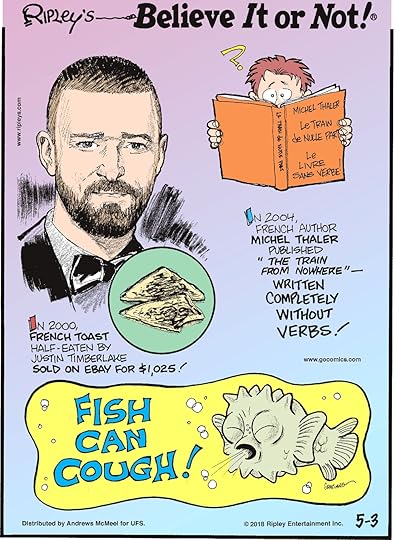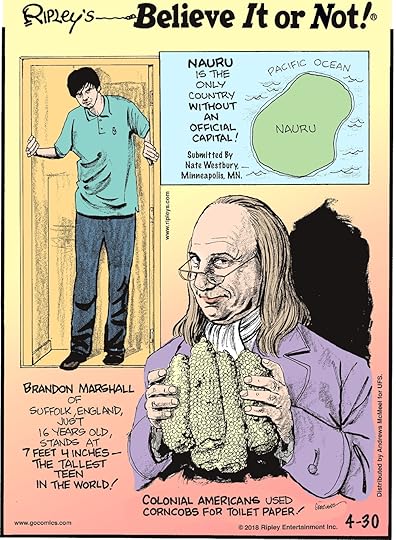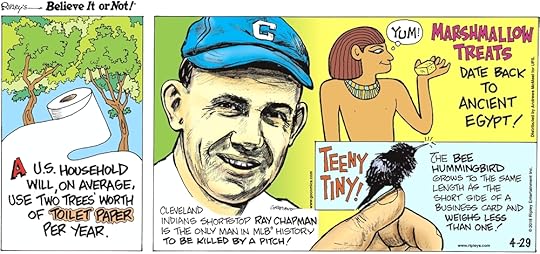Ripley Entertainment Inc.'s Blog, page 346
May 3, 2018
Think A Coin Toss Is A 50/50 Shot? Think Again!
Featured in Ripley's Believe It or Not!
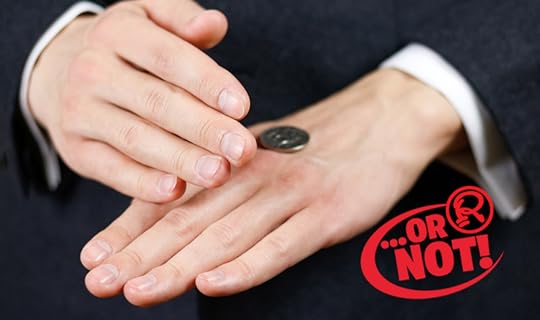
Or Not
In today’s world many misconceptions have been perpetuated—becoming modern day “facts”—when, in reality, myths and hearsay have taken over. Sorry to burst your bubble, but in this weekly column, Ripley’s puts those delusions to the test, turning your world upside down, because you can’t always…Believe It!
Today: Coin tosses aren’t 50/50.
Is A Coin Toss Fair?
Persi Diaconis did not begin his life as a mathematician.
In fact, as a teenager, he was doing his best to expose scammers at a Caribbean casino who were using shaved dice to better their chances against their customers.
He would go on to tackle other numbers games, like how shuffling decks of cards didn’t really mix up the deck.
By that time he’d dropped out of high school and was traveling the country with a magician, perfecting his sleight of hand. He did that for 10 years, and by age 24, he was taking classes at City College of New York, paying his way by doing magic tricks during the day. After getting two of his mathematical card tricks published in Scientific American, he used his editor’s recommendation to get him into Harvard as a statistics student. Three years later, he’d earned his doctorate and joined the Stanford faculty.
Diaconis then began to study other instances of change, questioning whether the things we think we know are, in fact, true.
Like the coin toss, for example. Most people assume the toss of a coin is always a 50/50 probability, with a 50 percent chance it lands on heads, and a 50 percent chance it lands on tails.
Not so, says Diaconis. And, like a good mathematician, he’s proven it.
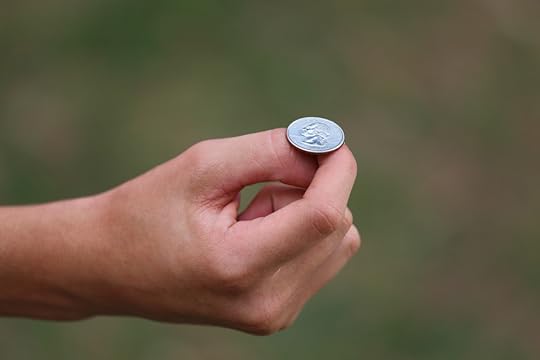
“I have spent years analyzing the basic images of randomness,” he said in an episode of the Annenberg Learner Against All Odds series. “First of all, it’s possible to make things random. If you flip a coin quite vigorously, it’s as close to being a fair event—50/50—as I know, if you flip it and catch it on your hand… However, we usually don’t do them vigorously… If you think about it the least little bit, you’ll realize it’s not random at all. In fact, there are people around carnivals, and I, on occasion, have been able to flip a coin and keep control over it.”
Probability Versus Physics
The coin toss is not about probability at all, he says. It is about physics, the coin, and how the “tosser” is actually throwing it. The majority of times, if a coin is heads-up when it is flipped, it will remain heads-up when it lands. Diaconis has even trained himself to flip a coin and make it come up heads 10 out of 10 times.
A similar effect is seen if the coin is spun. Because of the way most coins are made, the “heads” side can weigh more, which means it will fall on that side, leaving the other side up more often. Further, some magicians will have coins that are shaved, giving more weight to one side. The point? It’s not 50/50 at all.
“Most people think, ‘This guy’s nuts,’” Diaconis said in an interview with the Numberphile website. “But if pressed, people, when pushed, seem to think that a coin dropping on the floor is fairer… when a coin hits the ground, before it dies, often it spins around on its edge. And some of that edge bias comes in.”
He laughs.
“Coin tossing is pretty close to fair,” he said.
But it’s not 50/50.
Team Toss
This brings us to the discussion of sports, and those that involve coin tosses to decide a team’s possession. Are they fair? Firstly, Super Bowl coins are much larger.
“And the effect is probably much bigger,” Diaconis said. His advice? “Try to catch a glimpse of how it starts out.” Is it heads-up when it’s flipped? Then bet on it coming up on that same side.
It’s not magic at all. It’s math.
“That kind of thought has led a group of us to say that probability isn’t a fact about the world,” Diaconis said in the Against All Odds interview. “Probability is a fact about an observer’s knowledge.”
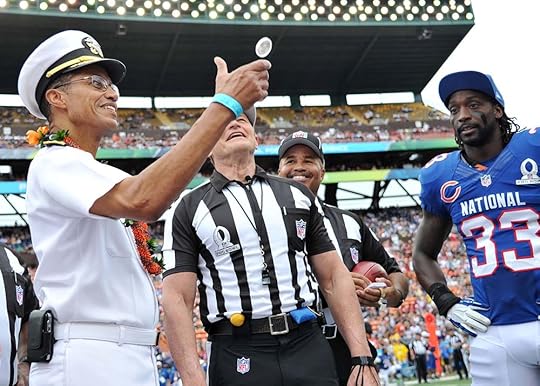
Definitely not a quarter.
By Ryan Clark, contributor for Ripleys.com
CARTOON 05-03-2018
May 2, 2018
Cadaver Synod: The Trial Of Pope Formosus’s Corpse
Featured in Ripley's Believe It or Not!
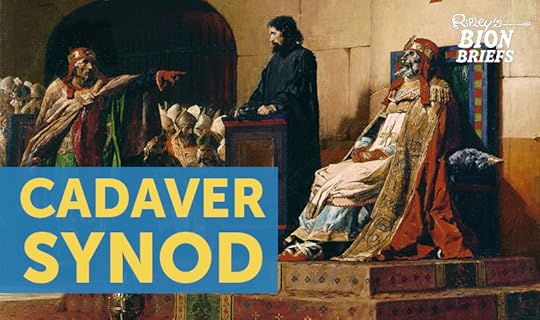
Believe it or not, the Catholic Church was once so upset with one of its own Popes that they dug up his corpse and put him on trial. The case against the late Pope Formosus became known as the Cadaver Synod.
Pope Formosus
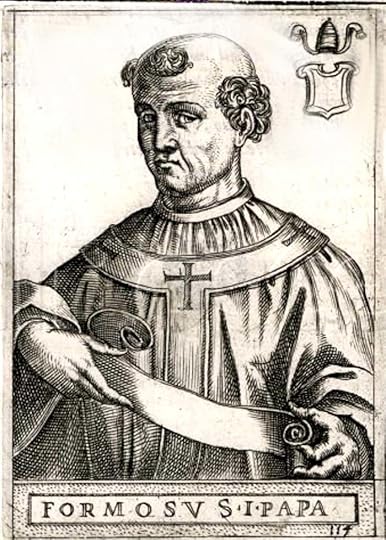
Formosus—whose pre-Pope name has been lost to the annals of history—spent his early days in the Priesthood traveling through Bulgaria and France attempting to lead missions, but never found much success. He eventually became so disgraced that the papacy excommunicated him, stripping him of access to its resources and making him promise to remain in exile from Rome.
Undeterred, Formosus returned to Rome and begged for forgiveness. Pope John VIII relented and allowed Formosus back in, needing his influence with the Bulgarian court to stabilize the turgid politics of the Holy Roman Empire at the time.
In the coming decades, Rome cycled through three more popes before Formosus himself was unanimously elected to the office in 891 AD.
Changing Pope’s during this period usually meant a complete redaction of the previous Pope’s edicts and strategies, and the newly-elected Formosus was highly distrustful of the current co-emperors of the Holy Roman Empire. Seeking to unseat Guy Spoleto III, Formosus asked Arnulf of Carinthia—who had just taken over Charles the Fat’s throne—to invade Rome and free it from Spoleto control.
The Trial Of A Dead Pope
Unfortunately, the plan failed, and Formosus died some years later. Despite his death, the many enemies he had made in life sought retribution. A year after his death in 896, Pope Stephen VI had Formosus’s body pulled out of the ground, dressed in papal vestments and placed on the throne to stand trial.
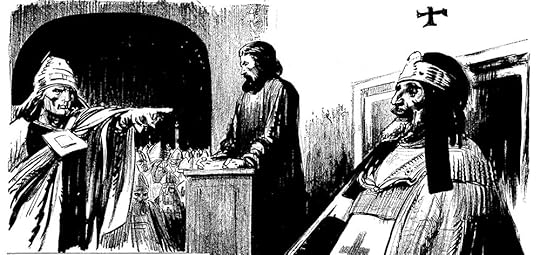
A deacon was provided to answer for the lifeless Formosus, but no one really defended him. Formosus was declared unworthy to have ever been Pope, and his reign and decrees were all stricken. Furthermore, they cut off his fingers of consecration and tossed his body into the Tiber River.
His body was retrieved by monks, but it wasn’t until the death of Stephen VI that Formosus’s body would be reinterred at St. Peter’s Basilica. Trials against the dead were banned for a time, but Pope Sergius III reinstated the actions against Formosus, and a back and forth of these actions took place for some time before the body was exhumed again, retried and beheaded.
Today, the Catholic Church supports none of these findings, disregarding them as political.
CARTOON 05-02-2018
May 1, 2018
Naga Headhunters’ Buffalo Teeth Necklace
Featured in Ripley's Believe It or Not!
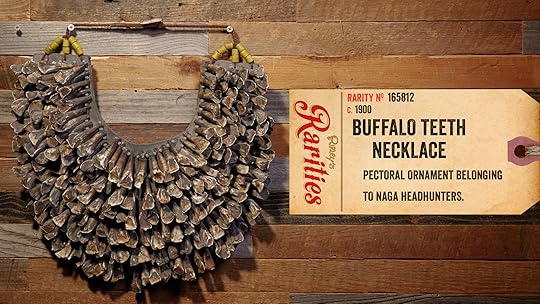
The Naga people of Assam, India, and western Myanmar have long been regarded as fearless warriors and bloodthirsty headhunters.
The Naga were so renowned for their proclivity for fighting that the British enlisted their help in guarding the evacuation road out of Burma to India during World War II. Their later participation in the Battle of Kohima, against the Japanese, is considered pivotal to the war in India, as well as a turning point in their own history.
Buffalo Teeth Necklace
This pectoral ornament hails from a Naga tribe and would have been a great symbol of power. The necklace is comprised of around 200 wild water buffalo teeth. Six tiers of teeth fill out the piece and are topped by glass beads, held together with a polished shell.
Each Naga tribe kept a house of skulls and battle trophies in the village, and the men of the village were expected to regularly contribute. Men who were lackluster in their bloodthirsty pursuits faced scorn, and would even be referred to as cows by the tribe. This cultural slur deepens the symbolism of the necklace.
Despite being the butt of Naga insults, wild water buffalo—also known as the Asiatic buffalo—is dangerous in its own right. They weigh in around 2,600 pounds and have sweeping crescent-shaped horns that can stretch six-and-a-half feet across.
Today, the wild water buffalo is highly endangered, and researchers estimate only a few dozen herds survive in Asia. Like the buffalo they hunted, headhunters in Naga are disappearing just as quickly. As recently as 1969, tribes were still attacking each other and displaying defeated warriors’ heads in their trophy houses.
It has been the work of Christian missionaries in the region since the British occupation of India that has led to their cultural shift away from headhunting and animist worship. Nevertheless, the state of Nagaland remains isolated, limiting tourism, and even requiring visitors check in to local police stations as they travel for everyone’s safety.
The Huge Appetite Of Louis XIV And The Scientist Who Ate His Mummified Heart
Featured in Ripley's Believe It or Not!
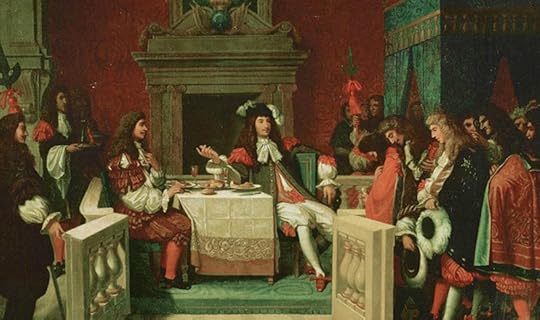
When French King Louis XIV died in 1715, his stomach was reportedly twice the size of the average human. Louis was known for his voracious appetite, but little did he know that three-quarters of a century after his death, one of his organs would become a meal of its own. William Buckland, a geologist and the Dean of Westminster, ate his heart.
Louis, known as the Sun King, started building Versailles in the 1660s by transforming the land’s royal hunting lodge into a palace. When he moved there permanently, many of his rituals revolved around food.
Following a light breakfast and a hefty lunch, his evening meal, called The Grand Couvert, took place around 10 p.m. It was served in his apartments, and members of the royal family, courtiers, and the public attended. Sometimes musicians would play for the king and his guests.
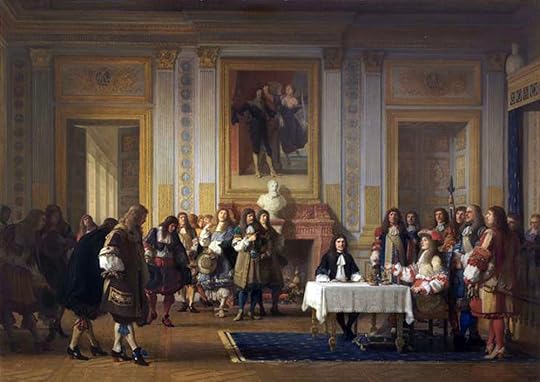
A typical meal consisted of a whopping 20 and 30 dishes. The first course was hors d’oeuvres such as pheasant, shellfish, soup, and Pâté. Fruit was served in the shape of large pyramids. Other dishes included roasts and pies of chicken, turkey, duck, boar, venison, and beef. Sometimes turtles were served alongside rice and vegetables. Oysters, salmon, and sardines were staples, as was potage—meat boiled with vegetables.
According to his sister-in-law, the Princess Palatine, the king had an insatiable appetite. She is recorded as saying: “He could eat four plates of soup, a whole pheasant, a partridge, a large plate of salad, two slices of ham, mutton au jus with garlic, a plate of pastry, all followed by fruit and hard-boiled eggs.”
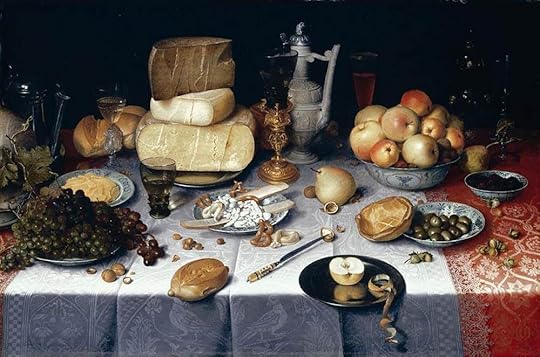
How did Louis consume so much food? Was his stomach really larger than the average man? The size depends on the person. Typically, a stomach’s volume is a little over one quart. But because the stomach is a muscle, it can expand and contract and hold up to a gallon of milk. When a person eats his or her stomach stretches, and after food is digested it returns to its original size. Overeating can cause a stomach to expand, and Louis was known for his love of food.
While Louis was a voracious eater, much of his selections were healthy—he had a taste for salad and was known to eat a good amount of raw vegetables. The king typically drank wine or champagne with his meal. Drinks were kept on side tables, and if the king or a courtier wanted a refill, they would ask the servers to pour a drink for them in a discreet manner.
Louis preferred to eat with his fingers even though the use of forks was starting to gain popularity in the 17th century. He reportedly forbade his children from using forks as well, noted Ferdinand Braudel in The Structure of Everyday Life. The Sun King permitted his courtiers to use spoon and knives—as long as the implements had dull, rounded edges. In 1669, Louis decreed that the points of knives used at the dining table be ground down so they could not be used as weapons.
Over 300 people, known as the Service de Bouche (service of the mouth) were employed to prepare the king’s meals, which were served on silver plates. Guards would escort the food from the kitchens (located about ¼-mile away from where The Grand Couvert took place) to the table, and servants would announce each dish to the king and courtiers. Guests would often join the king while he dined, although not all of them ate. Some would just stand and watch the king chow down.
When Louis was done with a course, servants would clear all the plates, regardless of whether everyone else had finished their meals. On the way up to bed at around 11:30 p.m., he would eat some candied fruit.
Death Of A King
The Sun King, 77, died on Aug. 13, 1715, a few weeks after complaining about a pain in his leg. He became seriously overweight in old age, and his left leg turned gangrenous. Biographers later speculated he may have had type 2 diabetes. Lack of exercise, unhealthy food choices, and obesity can increase the risk of developing the disease.
Louis served 72 of his years as king—and as a lover of food. During the autopsy, his corpse was divided into three parts (body, heart, and entrails), a tradition for French kings that started several centuries earlier. Louis’ heart was embalmed and placed in Eglise des Jésuites on Rue Saint-Antoine in Paris.

Eglise des Jésuites
During the French Revolution, the Sun King’s heart was stolen, and it ended up in the possession of Lord Harcourt, the Archbishop of York. The story goes that William Buckland visited Harcourt in 1848 and learned of the mummified heart. He reportedly couldn’t resist a taste, so he gobbled it up. It’s unclear whether he asked permission to eat it or simply swallowed it on impulse. His behavior wasn’t out of the ordinary for the scientist, who was so obsessed with strange food that he vowed to eat a piece of every single creature from the animal kingdom—and the heart of a king was apparently too good to pass up.
Noelle Talmon, contributor for Ripleys.com
Source: The Huge Appetite Of Louis XIV And The Scientist Who Ate His Mummified Heart
CARTOON 05-01-2018
April 30, 2018
CARTOON 04-30-2018
April 29, 2018
CARTOON 04-29-2018
April 28, 2018
CARTOON 04-28-2018
Ripley Entertainment Inc.'s Blog
- Ripley Entertainment Inc.'s profile
- 52 followers


